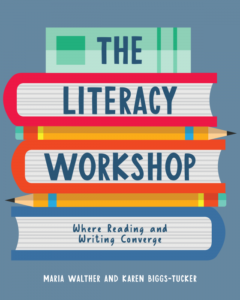Where Reading and Writing Converge
The Literacy Workshop: Where Reading and Writing Converge
By Maria Walther and Karen Biggs-Tucker
(Stenhouse, 2020 – Learn more)
Reviewed by Linda Biondi

While taking a walk with a colleague this winter, masked up and teeth chattering, we returned to the never-ending question: “How do we get enough time to teach literacy and be effective?”
My friend and I exchanged ideas and then settled on what we felt was the best for our students: take a deeper look into our reading and writing curriculum, find the overlaps, and plan on a way to meld the reading and writing workshop.
A workshop for reading AND writing

Authors Maria Walther and Karen Biggs-Tucker recognized the strong link between reading and writing. “We noticed that when the opportunities arose to combine our reading and writing workshops, we had more time to spend on big ideas and students were able to uncover exciting connections.” It absolutely made sense.
Think about it. As educators, we know that reading and writing depend on many of the same skills: the ability to decode words, spell words, pronounce words, communicate a message. Reading and writing. It’s like cheese and crackers. Romeo and Juliet. Peanut butter and jelly. They just go together.
An easy-to-follow guide
In the book’s nine chapters, the authors provide an easy-to-follow, research-based guide for teachers (K-8) to begin their journey into making a dual workshop a reality. As the publisher describes it, it is “a first-of-its-kind resource that offers a practical process for creating an integrated literacy workshop.”
The first section offers a view into the workshop and how the reading and writing components can be reciprocal. Chapter two continues with tips for planning the workshop. Chapter three covers launching the literacy workshop while chapter four guides the teacher on how to engage the students to become more independent.
If that isn’t enough, the second part of the book provides 44 demonstration lessons to try in a primary or intermediate grade level literacy workshop. There are two lesson plans for each objective, one for the primary classroom and the other for the intermediate classroom, along with mentor texts, lessons that follow the gradual release format, and anchor charts that address the specific instructional level.
For example, chapter six focuses on the habits of inquisitive learners. The mentor text for the primary grades is Ada Twist, Scientist by Andrea Beaty (2016), while the mentor text for the upper grades is Starstruck: The Cosmic Journey of Neil deGrasse Tyson by Kathleen Krull and Paul A. Brewer (2018).
Although both books address the big idea of the habits and behaviors of people who question, the specific mentor texts focus on the interest level, background knowledge, and reading/comprehension levels of each group.
The authors are veteran teachers who recognize and can relate to the pressures that educators face: not enough time, how to motivate the students, where to find resources. The authors include anecdotes from their own classrooms so the reader can peek inside a classroom where literacy integration is successful.
Why choose this literacy book?
Admittedly, there are many books about teaching literacy, and as educators we are in a quandary in choosing which one/s to purchase. I highly recommend this book for several reasons. First of all, there are lesson plans you can easily adapt to your own classroom. In addition, as you are reading the book you feel as if you are chatting with a friend or colleague.
Furthermore, as educators we are often “up against the clock.” We simply don’t have enough time to accomplish everything we want to do. This book is full of samples of student work, charts, diagrams, photos, and mentor texts with lesson plans. Each lesson plan ends with “What’s Next?”, a short section that encourages the teacher to reflect on the lesson.
Using the ideas in this book can transform your classroom. It can perhaps give you some time to take that walk with a friend and engage in professional conversations about literacy or give you some extra time to just enjoy walking and talking with each other. The Literacy Workshop: Where Reading and Writing Converge by Maria Walther and Karen Biggs-Tucker is a gold mine. Enjoy!
After teaching fourth and fifth graders for 41 years, Linda Biondi is supervising preservice and student teachers at The College of New Jersey and Rider University. Last summer she co-facilitated a week-long writing institute in conjunction with the National Writing Project at Rider University. She volunteers for two service organizations: Homefront and Dress for Success of Central New Jersey – both have a mission to end poverty and homelessness. The mission of Dress for Success is to empower women to achieve through economic independence.



































